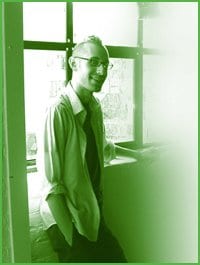Cumulus is a slow and meditative video-noir piece infused with charged moments. On a prairie expanse in summer, a cherubic pre-pubertal blonde haired boy frolics innocently in the tall grass.
There is a childlike but forbidden sensuality about the boy as he plays alone with a utility ball and later bites seductively into an apple. The soundtrack of moaning cello haunts the boy’s innocence and his isolation from the world.
The isolation also emphasizes whatever relationship there is between the boy and the only other human figure in the piece.
He is a man dressed in the 1950s heterosexist drag of Ward Cleaver and Joe Friday. It’s a dark slim-fit suit with striped necktie, white collared shirt, sensible city shoes and ubiquitous fedora.
There is a sinister quality to this man perhaps related to the repression, inflicted authority and homogeneity symbolized in his clothes, perhaps also related to the implausibility of such an urban and anachronistic figure lurking in the rural prairie grass. Certainly, the juxtaposition of this man to the boy piques the viewer’s curiosity about the relationship between the two.
“When I made this piece,” says artist Daniel Anderson, “I was interested in the sexualization of youth in gay male culture. I like to play with stories of relationships.”
One inescapable underlying theme in Cumulus is a flirtation between the man’s repression and authority and the boy’s sensuality. “I was thrust into a culture of male sexuality at a very young age,” says Anderson. “I could see, not really the beauty, but the rawness and significance of it and I was made painfully aware of a fascination in the gay world with youth. These are issues people tend to avoid.”
“Any time you invoke sexuality in a raw way,” he continues, “it will invoke assumptions. If I hadn’t made the man a little sinister, it wouldn’t have created the tension for the audience I wanted.”
The man, as the ’50s father figure, also subtly pushes power dynamics and paternity. Anderson is quick to point out that the most sinister interpretations of Cumulus are not the only ones. “The whole pedophilia issue does make people uncomfortable,” he says. “I am a little concerned people will see that one interpretation as more over-arching than it really is. People do have a fear of intergenerational same-sex relationships that almost becomes irrational and I did want to explore that.”
Anderson says the work is not designed to provoke dialogue; it’s designed to get people to think. For him, the reaction viewers have in their minds is more important but he does concede that if people weren’t so fearful about sexual taboos and made a greater effort to understand them, we’d be in a much better position to deal with these issues more constructively.
Anderson is a lanky guy with full lips and an easy smile. He wears a very sporty mohawk hairstyle and he took special measures to ensure his extra hip eyeglasses were glued back into one piece before he met with Xtra West.
He is very much at home in Simon Fraser University’s bustling and ultra-cool loft studio overlooking the dockyards. He says although there are lots of artists in Vancouver who happen to be queer, there aren’t many who explore queer themes in their art and even fewer who identify themselves as queer artists.
“It’s a bit dangerous in terms of career to call yourself a queer artist,” says Anderson. “It’s perceived by the art community as a little sophomoric to bill yourself that way. Lord knows there are lots of queers in the art world, but people have moved beyond that element of questioning and are addressing the broader questions of who they are.”
The legitimization and commodification of experimental and subversive art seems both its own goal and ultimate path to oblivion. It’s the path queer art has largely taken over the past 15 years and the path Anderson’s work haltingly flirts with.
The avant-garde tide has been against queerness in subversive art since famed queer photographer Robert Mapplethorpe’s gritty homoerotic work was thrust into the mainstream by, irony of ironies, social conservative and religious fundamentalist elements in the United States.
By exposing the grittiest and most graphic expressions of underground homoerotic art to the light of public scrutiny, Mapplethorpe’s work at once helped to liberate raw depictions of queer sexuality and to make them unfashionable.
Mapplethorpe’s queer work was tragically relegated from the avant-garde to the annals of queer art history and dragged with it a critical outlet of pure queer sexual expression.
Although Anderson is hesitant to label himself a queer artist, his work does explore sexual taboos and mass neuroses in the queer world.
Anderson hopes to strike a balance between subversion and legitimization. “Experimental art has its own place and can’t be popular,” he says. “It has to exist on the periphery, but it also has to engage people.”
Anderson is one of 17 artists contributing to Simon Fraser University’s fourth-year Graduate Exhibition running Apr 15-27 at Alexander Studios.
CUMULUS.
Fourth-year Graduate Exhibition.
Simon Fraser University.
Apr 15-27
Alexander Studios.
611 Alexander St

 Why you can trust Xtra
Why you can trust Xtra


